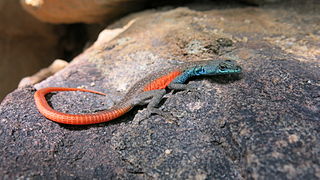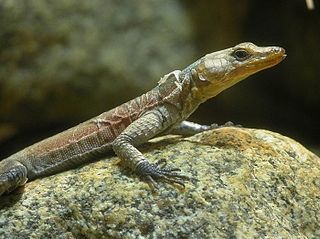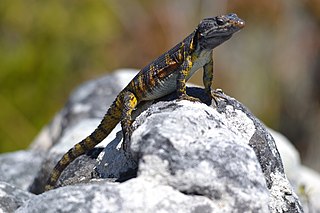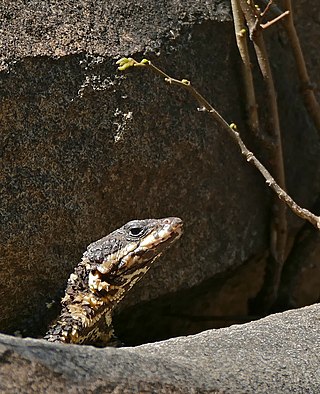
Leiocephalidae, also known as the curlytail lizards or curly-tailed lizards, is a family of iguanian lizards restricted to the West Indies. One of the defining features of these lizards is that their tail often curls over. They were previously regarded as members of the subfamily Leiocephalinae within the family Tropiduridae. There are presently 30 known species, all in the genus Leiocephalus.

The Mexican blind lizard is a species of legless lizard in the family Dibamidae, and the only species in the genus Anelytropsis. It is endemic to Mexico. They look like Amphisbaenia, but are in fact, only distantly related.

The slender glass lizard is a legless lizard in the glass lizard subfamily (Anguinae). The species is endemic to the United States. Two subspecies are recognized. The lizard was originally believed to be a subspecies of the eastern glass lizard. Their name comes from their easily broken tail which they can break off themselves without ever being touched. It is difficult to find a specimen with an undamaged tail. The lizard eats a variety of insects and small animals, including smaller lizards. Snakes and other animals are known to prey on the species. Humans have a part in destroying their environment and killing their food supply with insecticides. The lizard is considered to be a least-concern species according to the International Union for Conservation of Nature (IUCN), though it is vulnerable in Iowa and endangered in Wisconsin. It is important to note that the streamlined, legless species is often confused with snakes. Glass Lizards, however, differ from snakes as they possess a moveable eyelid, which is absent in snakes. Another way to distinguish glass lizards from snakes is the presence of an external ear opening, which are absent in snakes.

The Bermuda skink, longnose skink, or Bermuda rock lizard is a critically endangered species and the only endemic land-living vertebrate of Bermuda. It is a relatively small skink : adults reach an average snout-to-vent length of about 8 cm (3.1 in).
The lizard catshark is a small shark species of the catshark family, Scyliorhinidae, found off the coast of southern Brazil on the upper continental shelf at depths of between 250 and 500 metres.

The wildlife of South Africa consists of the flora and fauna of this country in southern Africa. The country has a range of different habitat types and an ecologically rich and diverse wildlife, vascular plants being particularly abundant, many of them endemic to the country. There are few forested areas, much savanna grassland, semi-arid Karoo vegetation and the fynbos of the Cape Floristic Region. Famed for its national parks and big game, 297 species of mammal have been recorded in South Africa, as well as 849 species of bird and over 20,000 species of vascular plants.
Hemicordylus nebulosus is a species of lizard in the Cordylidae family. It is endemic to South Africa on the mist belt of northern slope of the Hottentots Holland Mountains. The scientific name, H. nebulosus means cloud or dark crag lizard. The name was given due to the melanistic body color. Other names include the dwarf cliff lizard, dwarf crag lizard, dark crag lizard and the cloudy crag lizard.

The Waterberg flat lizard is a species of lizard in the family Cordylidae. It is endemic to South Africa.
The dwarf flat lizard or lesser flat lizard is a lizard in the family Cordylidae. It is found in Southern Africa.
The spotted flat lizard is a lizard in the Cordylidae family, which is native to Mozambique.

The Pungwe flat lizard is a species of lizard in the Cordylidae family.

The Mozambique girdled lizard or flame-bellied armadillo lizard is a large, flattened, girdled lizard found on Mount Gorongosa in Mozambique and low elevations in the Chimanimani Mountains at the border of Zimbabwe and Mozambique. It lives in rock outcrops in grasslands and dry, wooded mountain slopes.
Cordylus meculae, the Mecula girdled lizard, is a third species from the Rhodesian girdled lizard complex, and was described from Mount Mecula in northern Mozambique. It lives in granite outcrops of montane grasslands and dry miombo woodland. The nostril pierces the center of the nasal scale and the head shields are rugose. The dorsal coloration is dark brown with paler infusions on the flanks. The head is almost black with yellow lips and scattered yellow flecks on the head and neck. The belly is buff colored.

Pseudocordylus microlepidotus, or the Cape crag lizard, is a species of lizard native to shrublands and grasslands of South Africa. Three subspecies have been named: Pseudocordylus microlepidotus microlepidotus, Pseudocordylus microlepidotus fasciatus, and Pseudocordylus microlepidotus namaquensis. The species' gestation type is ovoviviparous. The species is protected under Convention on International Trade in Endangered Species of Wild Fauna and Flora (CITES).
Tretioscincus agilis, the smooth tegu, is a species of lizard in the family Gymnophthalmidae. It is found in Guyana, Suriname, French Guiana, Brazil, Venezuela, and Colombia.

Tretioscincus bifasciatus, the Rio Magdalena tegu, is a species of lizard in the family Gymnophthalmidae. It is found in Suriname, French Guiana, Venezuela, Margarita Island, Aruba, Curaçao, Bonaire, and Colombia.

Smaug barbertonensis is a species of lizard in the family Cordylidae. It is a small lizard found in eastern South Africa and Eswatini.
Smaug regius is a species of lizard in the family Cordylidae. It is a small lizard found in Zimbabwe.

Iguanodectidae is a family of freshwater fish in the order Characiformes that lives in South America. It is home to the subfamily Iguanodectinae and the monotypic Bryconops clade. Several species in the family, such as the green line lizard tetra, the tailspot tetra, and the orangefin tetra, are sometimes taken as aquarium fish.













